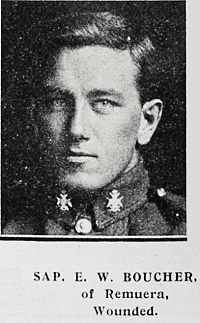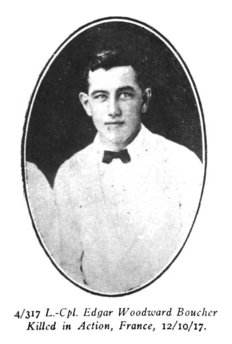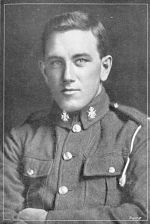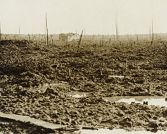WW1 Passchendaele Edgar and Arthur Boucher
Boucher Brothers — The Darkest Day
Edgar (known as Teddy) Woodward Boucher enlisted in New Zealand’s first military operation in World War 1 in Samoa and died in New Zealand’s bloodiest battle on the Western front of Europe when 846 young New Zealanders were killed in the Battle of Passchendaele. He was the eldest son of Ernest Woodward and Anna Augusta Vercoe Boucher of Westbourne Road, Remuera, born 15 November 1893. His father Ernest who was on the St Aidan’s Church Committee from 1905-06 and the vestry in 1914, was the son of the Rev A. F. Boucher, of Kempsey House, Worcester, England and had settled in Te Puke to farm along No. 3 Road.
Edgar was educated at St John’s School at The Pah in Onehunga from 1900 to 1910 and at Kings College. At school in 1910 as head prefect, he passed the matriculation and solicitors’ general knowledge examination, as well as winning the prize for Character, scholarship, leadership, and athletics. He also won prizes for elocution, Shakespeare and having the best drilled section in the cadet corps. [1] He attended Auckland University College from 1912-1914.[2] Edgar was also a senior cadet at College Rifles for four years in the Territorial Reserve.
On the declaration of war by New Zealand on 4th August 1914, he was employed as a surveyor’s assistant by Thomas McFarlane in the Victoria Arcade, Auckland. He quickly enlisted on the 8th August and joined College Rifles’ New Zealand Signallers Company. On the 15th August he was on his way to Apia on the Monowai as part of the Samoa Advance Party with the New Zealand Expeditionary Force. Britain had asked New Zealand to seize German Samoa as a ‘great and urgent Imperial service’ and New Zealand’s response had been swift. Led by Lieutenant-Colonel Robert Logan, the 1400-strong Samoa Advance Party landed at Apia on 29 August. There was no resistance from German officials or the general population.[3] On 4th January 1915 Edgar was discharged to take up civil employment with Mr McDonald as assistant surveyor in Apia.
However, after Gallipoli, Edgar returned to New Zealand and in October 1915 re-enlisted as a Sapper in the 9th Reinforcements New Zealand Engineers, sailing from Wellington on the Maunganui to Suez, Egypt. He disembarked at Alexandria, went by train to Zeitoun Camp near Cairo for training and then joined the other N Z Signallers at El Moascar, Ismailia. On the 6th April 1916 he left Alexandria on the S S Minnewaska for Marseilles, France. On board were 65 officers, 1,667 troops and 468 animals (horses, mules, bullocks).[4] Edgar was wounded in the leg at Pozieres, northern France during the Battle of the Somme, on 25 July 1916, was admitted to hospital near Calais and discharged to Base Details at Etaples in August. In October 1916 he rejoined the New Zealand Signallers in France. Edgar was probably involved in the successful taking of Messines from the Germans in Belgium in June 1917. On the 11 August 1917 he was granted one week’s leave in England.
On October 12th 1917, Edgar was reported missing in action. The New Zealand Division’s involvement in the Third Battle of Ypres, attacking the Passchendaele Ridge resulted in what remains New Zealand’s most disastrous military day. On 4 October the division had captured Gravenstafel Spur, and a week later was given the objective of capturing Bellevue Spur. On 12 October New Zealand troops attacked across waterlogged ground at Passchendaele suffering some 3,700 casualties without gaining Bellevue Spur: 45 officers and 800 men were either dead or lying mortally wounded between the lines. In terms of lives lost in a single day, this remains the darkest day in New Zealand’s post-1840 existence. [5]
On 12 October 1917 Edgar had been laying cable under heavy shellfire at Passchendaele. Like many other New Zealand men at the end of the battle he was missing. A court of enquiry was held to determine his status in May 1918 which concluded he was killed in action. Sappers Weir and McKenzie gave evidence at his enquiry:[6] Weir: “I was a member of Lieutenant Harty’s line party. In the attack on Passchendaele, our party’s job was to lay the line to the forward stations of attacking brigades. The last I saw of him was when he was making joints when we came to the end of the first drum of cable. This was near Fleet Cottage. Corporal McKenzie: I was also a member of Harty’s party. The last I saw of him on the day in question, was when he was taking shelter from the shelling near Fleet Cottage. I could see him from a dugout about 40-50 yards to the south. I saw him crawl out of sight and if he remained, he was certainly killed as the shelling was intense.”
Edgar is remembered at the Tyne Cot Cemetery, Zonnebeke, West-Vlaanderen in Belgium along with many other young New Zealanders who went missing on our darkest day. A memorial to Edgar was dedicated at St Aidan’s Church, Remuera by the Bishop of Auckland Dr A W Averill on 1st September 1918, in the form of a Gothic brass, with the following inscription: “Remember Edgar Woodward Boucher, a brave soldier, who sought God’s grace in the ministrations of His Church to help him to live and to do his duty faithfully to God and King. He obeyed the call of his country in the first week of the Great War and fell in action October 12, 1917. Aged 24.” At the top of the brass is engraved the badge of the College Rifles and the crest of the deceased soldier’s family.[7]
Angela Caughey wrote in her book about St Aidan’s Church of the community being deeply distraught at the deaths of church members: ‘Teddy’ Boucher, the son of a former vestryman, was killed. People came in large numbers to the special Gallipoli commemoration service, to the Easter services and to Holy Communion. …The dedication of the Edgar W Boucher memorial plaque saw cadets in uniform, carrying handsome silk flags, standing at attention by the memorial, as the bishop unveiled it.” [8] Edgar is also remembered on the Rolls of Honour at Kings College and College Rifles.
Edgar, however, was not the only Boucher son to fall in WW1. His brother Arthur Francis Boucher, born 20 August 1895, was also a Sapper with the New Zealand Engineers, Divisional Signals Company in France. He was wounded on the 4 Oct 1917 with a gunshot wound to the right thigh and admitted to hospital in Camiers Dannes in France and then to Walton-on-Thames hospital in England in February 1918. He rejoined the Signallers at Stevenage in May. On 27th August 1918 he was married to Dora Annie Walton at All Saints Church in Lincoln by the Rev. Swaney. But he fell ill and was discharged to Torquay for return to New Zealand. On the 31st January 1919 his record notes he was seriously ill with pneumonia and died on 6th February 1919 at Prees Heath Military Hospital in Shropshire. [9] He was buried at St Swithin’s Cemetery in Lincoln by the Rev E J Swaney, who had married him and Dora six months before. Arthur is also remembered on the brass plaque at St Aidan’s Church and on the Rolls of Honour at College Rifles and Kings College.[10]
The plaque at St Aidan’s says:
Edgar Woodward Boucher
A brave soldier who sought God’s grace in the
Ministrations of HIS Church to
Help him to live and to do his duty
Faithfully to God and King.
He obeyed the call of his country
in the first week of the Great War
and Fell in Action
12 October 1917
Aged 24
Also Arthur Francis Boucher
Who died on active service
6 February 1919
Aged 23





